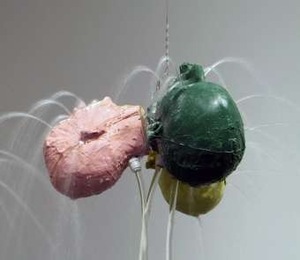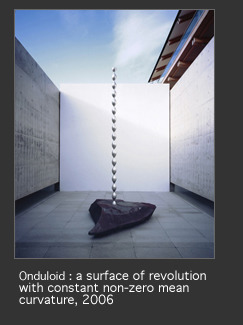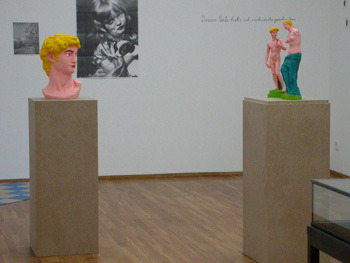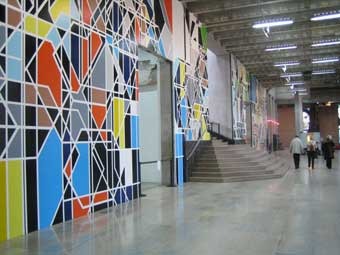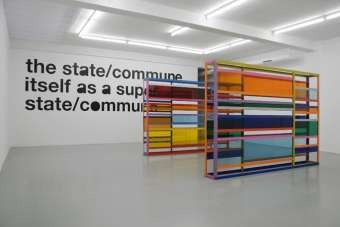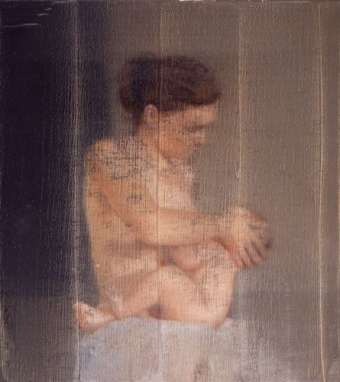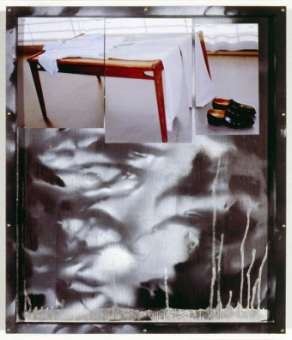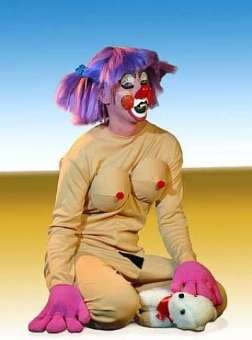THE BEST ACCORDING TO PRINCIPLE OF COMMONSENSE 0
Rasa Andriušytė
www.kamane.lt , 2010 03 04
Is it possible to answer the question reasonably why one artist or work of art is better than another? What could we lean upon if we discard the subjective opinion, snobbish interests and criteria of short-term fashion and commercial success in the local market? In order not to invent the local bicycle again, Dr. R.Andriušytė invites to take a look at the world where the mechanism of establishing the value of an artist or work of art has already been invented and functions perfectly.
The annual ratings of the most important artists, most influential museums, most significant conceptual group exhibitions and biennials are made in the world for about forty years already. The opinion of professional art experts is referred to in Great Britain. The British magazine Art Review elected Damien Hirst (b. 1965) and his project Science Ltd. the most important artist of 2009. The glory of an artist is measured by the evaluation system called Art Compass (Kunstkompass) in Germany since 1970. Seeking to achieve clarity and transparency in the evaluation of contemporary art, it was created by two journalists of Koln: art critic Linde Rohr-Bongard and economist Willi Bongard, editor of the business section of the daily Die Zeit in about 1970. Now the Art Compass of W. Bongard is considered to be the most competitive tool for establishing the importance of contemporary artists. Wall Street Journal has recognised this system as the only objective and reliable instrument for evaluating contemporary art.
Damien Hirst. Detail from the project Science Ltd. 2008. www.artem.com
The evaluation system created by W. Bongard is based on reactions of professional artists and art critics rather than the value of works in the art market and auctions. The assumption is made that art quality cannot be measured and that works cannot be compared as they are all unique. Art critics agree that, if art is “ugly” or otherwise “bad”, it does not mean that it is not art. Prestige gained (or not gained) by an artist among professionals through participation in exhibitions and receiving articles of critics analysing his/her works is considered the ground for evaluation in the German system. Not much significance is given to record prices or performance in auctions in this system. According to W. and L. Bongard, success in art markets is secondary; it is the material expression of prestige gained in the art world.
Five criteria are referred to in the evaluation system of Art Compass: 1. personal exhibitions in important world museums; 2. participation in important group exhibitions or biennials; 3. works acquired by important museums, e.g. Tate Modern; 4. reviews in the professional press and prestigious art magazines; 5. the name of the artist included into the “imagined museum”, which is created in the head and which is reflected in articles and books of famous art experts. The contemporary professional art world leans upon such widely recognised heights of artistic life as Museum of Modern Art in New York, Centre Georges Pompidou in Paris, articles in art magazines Art in America, Art, Flash Art, Kunstforum, Parkett rather than upon interests of a separate art field, town or country. Venice biennial or Kassel Documenta are considered to be the most important group exhibitions. The list includes more than one hundred famous exhibitions in the entire world.
The importance and prestige of an art institution that showcases a work or that has purchased it is a huge symbolic capital for an artist in the art field. Therefore, museums and exhibitions of the world are also evaluated annually in the system of Art Compass; points are given to institutions as well as artists. The following institutions are on the top of the list of 2009: Museum of Modern Art in New York, Neue Nationalgalerie in Berlin, Dusseldorf Kunstsammlung Nordrhein-Westfalien, London Tate Modern and Royal Academy of Arts. Prague Rudolfinum and Warsaw Zachęta, in which works of several Lithuanian artists have been exhibited, are in the list of 2009 among museums of Central and East Europe, in addition to two Leipzig institutions. Even though these two museums are in the last third of the list, they could become the starting point for Lithuanian artists. In the list of group exhibitions, the most important position is taken by Kassel Documenta and various biennials. Linde Rohr-Bongard, who prepared the ratings of 2009, distinguished Istanbul biennial as “fantastically favourable to art experiments”. Venice, Berlin, Goteborg, Sydney, Pittsburgh and Porto Alegre biennials have the highest evaluations.
With the help of computer software, the activities or artists and resonances about them are summed up and evaluated all the year round in the Art Compass system. The biggest amount of points is granted for personal exhibitions in the biggest museums, fewer points – for participation in group exhibitions and articles in the professional press. The art journalist Linde Bongard, who continues the husband’s work after his death, travels and visits the biggest exhibitions of the world all the time. She visited 233 museums, 118 group exhibitions and 40 new places related with contemporary art: Bombay, Seoul, Dahl, Beijing, Moscow, Istanbul during the latter year. She is also searching for new names in her trips. The last six places are allocated purposefully in the rating of L.Bongard to novices, who cross the line of the first one hundred artists. Three art photographers: Hiroshi Sugimoto (b. 1948), Hans Peter Feldman (b. 1941), Wolfgang Tillman (b. 1968); the film author and painter Sarah Morris (b. 1967), media artist Stan Douglas (1960), British creator of installations Liam Gillick (1964), who represented Germany in the 53rd Venice biennial and whose works were presented in the exhibition “Nobody” at Vilnius Contemporary Art Centre, are in these positions in 2009.
Hiroshi Sugimoto. Mathematic model. 2008. www.sugimotohiroshi.com
Hans Peter Feldman. Installation in Hamburger Bahnhof Museum. 2008. RamanoMaerzo. www.hamburgerbahnhof.de
Sarah Moris. Wall painting in Los Angeles. 2007-2008. www.postmedia.net
Liam Gillick. From the cycle "Out of Production". 2007. www.gms.be
The German artist Gerhard Richter (b. 1932) is in the first place in the Art Compass system for the fifth year in sequence. As a result, he is certainly considered to be the most important live artist of today. The American representative of object art Bruce Nauman (b. 1941) is in the second place, as one year ago. The third is the painter from Koln Sigmar Polke (b. 1941) in the alley of glory of the Art Compass. His exhibition was presented to visitors of Kaunas Picture Gallery at the end of 1997. The neo-expressionist Georg Baselitz (b. 1938) rose to the fourth place slightly unexpectedly due to the fact that important European museums hurried up with the organisation of his personal exhibitions dedicated to his seventieth anniversary. Three following positions are occupied by women: German Rosemarie Trockel (b. 1952) and two Americans, sculptor Louise Bourgeois (b. 1911) and art photographer Cindy Sherman (b. 1954).
Gerhard Richter. With a child. 1995. www.gerhard-richter.com
Bruce Nauman. Fountain of three heads. 2005. www.donalyoung.com
Rosemarie Trockel. She died. 2008. www.donalddyoung.com
Cindy Shermann. From the series of Clowns. 2004. www.arthistoryarchive.com
The success stories of artists who are among one hundred top artists according to Art Compass ratings are actively created by museum employees, art buyers, collectors and mass media. Ratings are granted every year. The place of an artist among one hundred top artists of Art Compass is a serious index for art market and investment. The works of the US painter Cy Twombly are 160 times more expensive today than in 1970, when he was first included into the Art Compass list. The value of steel sculptures of Richrdo Serra rose three hundred times with the help of Art Compass, despite the fact that one of them was moved out from New York square at the will of vox populi. Jean-Claude and Christo used to earn from EUR 5000 to 18 thousand from their works in 1970. Today their projects and ideas, which are almost always related with packing (packing of Reichstag, 1971-1995, packed Pont Neuf, 1975-1985), are bought for half a million of EUR. It is worth mentioning here that the prices of old art are set by the art market and auctions. The art and law specialist working in Munich Piroschka Dossi presents such data in the book “Art and Money“ (2007): the prices of old masters’ works increased by only 3.5 percent in 2004-2005, and the prices of contemporary art rose the most markedly – by 17.4 percent.
According to economists, the value of a work of art is acknowledged only when there are signs that the work may be potentially converted, i.e., exchanged for money. Not only an artist but also gallery owners and art sellers act in the process of converting. They turn art into money, which is understandable to everybody. Before art market players perform this rational act, a more subtle and much longer process takes place: the barometer of the art world is on, values are established by professional experts, which are as rational and relentless as the world of finance.
Prepared according to the foreign press.








